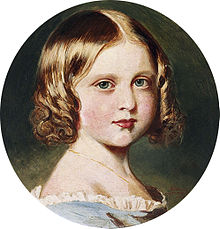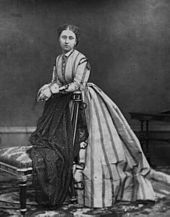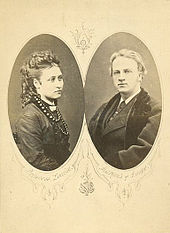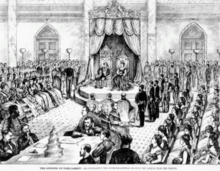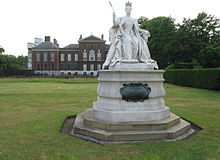- Princess Louise, Duchess of Argyll
-
Princess Louise Duchess of Argyll 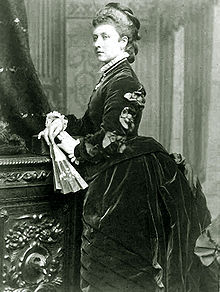
Princess Louise, c. 1870s Spouse John Campbell, 9th Duke of Argyll (earlier Marquess of Lorne) Full name Louise Caroline Alberta House - House of Windsor
- House of Saxe-Coburg-Gotha
Father Albert, Prince Consort Mother Queen Victoria Born 18 March 1848
Buckingham Palace, LondonDied 3 December 1939 (aged 91)
Kensington Palace, LondonBurial Frogmore, Windsor The Princess Louise (born Louise Caroline Alberta, also known as Marchioness of Lorne and Duchess of Argyll by marriage; 18 March 1848 – 3 December 1939) was a member of the British Royal Family, the sixth child and fourth daughter of Queen Victoria and her husband, Albert, Prince Consort.
Louise's early life was spent moving between the various royal residences in the company of her family. When her father, the Prince Consort, died on 14 December 1861, the court went into a period of intense mourning, to which Louise was unsympathetic. Louise was an able sculptor and artist, and several of her sculptures remain today. She was also a supporter of the feminist movement, and corresponded with Josephine Butler and visited Elizabeth Garrett. She held that "the subject of Domestic Economy lies at the root of the - highest life of every true woman."[1][page needed]
As an unmarried daughter of Victoria, Louise served as an unofficial secretary to her mother between 1866 and 1871. The question of Louise's marriage was discussed in the late 1860s. Suitors from the royal houses of Prussia and Denmark were suggested, but Victoria wanted new blood in the family, and therefore suggested a high-ranking member of the aristocracy. Despite opposition from members of the royal family, Louise fell in love with John, Marquess of Lorne, the heir to the Duke of Argyll, and Victoria consented to the marriage,[2] which took place on 21 March 1871.[3] Despite a happy beginning, the two drifted apart, possibly because of their childlessness and the Queen's constraints on their activities.[4]
In 1878, Lorne was appointed Governor General of Canada. Louise thus became viceregal consort, but her stay was unhappy as a result of homesickness and dislike of Ottawa.[4] Following Victoria's death on 22 January 1901, she entered the social circle established by her brother, the new King, Edward VII. Louise's marriage survived thanks to long periods of separation, but the couple reconciled in 1911, and she was devastated by her husband's death in 1914. After the end of the First World War in 1918, at the age of 70, she began to retire from public life, undertaking few public duties outside of Kensington Palace. She died at Kensington Palace on 3 December 1939 at the age of 91 years, 8 months and 15 days. Coincidentally, Princess Louise's younger brother Prince Arthur lived to be exactly the same age (to the day), making them the joint longest-lived of Queen Victoria and Prince Albert's nine children.
Contents
Early life
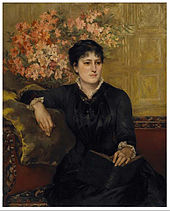 Portrait of Henrietta Montalba painted by Princess Louise in 1882
Portrait of Henrietta Montalba painted by Princess Louise in 1882
Louise was born on 18 March 1848 at Buckingham Palace, London.[5] She was the fourth daughter and sixth child of the reigning British monarch, Queen Victoria, and her husband Prince Albert of Saxe-Coburg and Gotha. As the daughter of the sovereign, Louise was styled Her Royal Highness The Princess Louise from birth. Her birth coincided with revolutions which swept across Europe, prompting the Queen to remark that Louise would turn out to be “something peculiar”.[6] The Queen's labour with Louise was the first to be aided with chloroform.[6] Albert and Victoria chose the names Louisa Caroline Alberta. Louise was chosen to honour Albert's mother. Though christened Louisa in Buckingham Palace's private chapel by John Bird Sumner, the Archbishop of Canterbury, on 13 May 1848, she was invariably known as Louise throughout her life.[7] Her godparents were Duke Gustav of Mecklenburg-Schwerin (her paternal great-great-uncle, for whom Prince Albert stood proxy); The Duchess of Saxe-Meiningen (for whom her great-aunt Queen Adelaide stood proxy); and The Hereditary Grand Duchess of Mecklenburg-Strelitz (her first cousin once-removed, for whom her mother The Duchess of Cambridge stood proxy).[7] During the ceremony, The Duchess of Gloucester, one of the few children of George III who were still alive, forgot where she was, and suddenly got up in the middle of the service and knelt at the Queen's feet, much to the Queen's horror.[6]
Like her other siblings, Louise was brought up with the strict programme of education devised by her father, Prince Albert, and his friend and confidant, Baron Stockmar. The young children were taught practical tasks, such as cooking, farming, household tasks and carpentry.[8]
From her early years, Louise was a talented and intelligent child, and her artistic talents were quickly recognised.[9] On his visit to Osborne House in 1863, Hallam Tennyson, the son of the poet Alfred, Lord Tennyson, remarked that Louise could “draw beautifully”.[10][clarification needed] Because of her royal rank, an artistic career was not considered. However, the Queen allowed her to attend art school under the tuition of the sculptress Mary Thornycroft, and she later, in 1863, enrolled at the National Art Training School,[11] South Kensington.[4] Louise also became an able dancer, and Victoria wrote, after a dance, that Louise “danced the sword dance with more verve and accuracy than any of her sisters”.[12] Her wit and intelligence made her a favourite with her father,[13] with her inquisitive nature earning her the nickname “Little Miss Why” from other members of the royal family.[12]
Death of Prince Albert
Louise's father, Prince Albert, died at Windsor on 14 December 1861. The Queen was devastated, and ordered her household to move from Windsor to Osborne House on the Isle of Wight. The atmosphere of the royal court became gloomy and morbid in the wake of the Prince's death, and entertainments became dry and dull.[14] Louise quickly became dissatisfied with her mother's prolonged mourning.[14] For her seventeenth birthday, Louise requested the ballroom to be opened for a debutante dance, the like of which had not been performed since Prince Albert's death. Her request was refused, and her boredom with the mundane routine of travelling between the different royal residences at set times irritated her mother, who considered Louise to be indiscreet and argumentative.[4]
The Queen comforted herself by rigidly continuing with Prince Albert's plans for their children. Princess Alice was married to Prince Louis, the future Grand Duke of Hesse, at Osborne on 1 June 1862. In 1863, Edward, the Prince of Wales, married Princess Alexandra of Denmark. The Queen made it a tradition that the eldest unmarried daughter would become her unofficial secretary, a position which Louise filled in 1866, despite the Queen's concern that she was indiscreet.[14] Louise, however, proved to be good at the job: Victoria wrote shortly afterwards: “She is (and who would some years ago have thought it?) a clever dear girl with a fine strong character, unselfish and affectionate.”[15] However, when Louise fell in love with her brother Leopold's tutor, the Reverend Robinson Duckworth, between 1866 and 1870, the Queen reacted by dismissing Duckworth in 1870. He later became Canon of Westminster Abbey.[16]
Louise was bored by the court.[17] By fulfilling her duties, which were little more than minor secretarial tasks, such as writing letters on the Queen's behalf; dealing with political correspondence; and providing the Queen with company, she had more responsibility than she had before.[17]
Marriage
Suitors
As a daughter of the Queen, Louise was a desirable bride; more so as she is regarded as the Queen's most beautiful daughter by both contemporary and modern biographers.[18] However, she was accused by the press, without substantiation, of romantic affairs.[4] This, coupled with her liberalism and feminism, prompted the Queen to find her a husband. The choice had to suit Victoria as well as Louise, and the Queen insisted that her daughter's husband should live near her, a promise also made by Helena's husband. Various suitors were proposed by the leading royal houses of Europe: Princess Alexandra proposed her brother, the Crown Prince of Denmark, but the Queen was strongly opposed to another Danish marriage that could antagonise Prussia.[19] Victoria, Louise's eldest sister, proposed the tall and rich Prince Albert of Prussia, but Queen Victoria disapproved of another Prussian marriage that would have been unpopular in England.[20] Prince Albert was also reluctant to settle in England as required. William, Prince of Orange was also considered a suitor, but because of his extravagant lifestyle in Paris, where he lived openly with a mistress, the Queen quickly vetoed the idea.[21]
Louise viewed marriage to any prince as undesirable, and announced that she wished to marry John Campbell, Marquess of Lorne, heir to the Dukedom of Argyll. No such marriage, between a daughter of a Sovereign and a British subject, had been given official recognition since 1515, when Charles Brandon, the first Duke of Suffolk, married Mary Tudor.[4] Louise's brother, the Prince of Wales, was strongly opposed to a marriage with a non-mediatized noble.[22] Furthermore, Lorne's father, George Campbell, the eighth Duke of Argyll, was an ardent supporter of William Ewart Gladstone, and the Prince of Wales was worried that he would drag the royal family into political disputes.[20] Nevertheless, the opposition was crushed by the Queen, who wrote to the Prince of Wales in 1869:
That which you object to [that Louise should marry a subject] I feel certain will be for Louise's happiness and for the peace and quiet of the family ... Times have changed; great foreign alliances are looked on as causes of trouble and anxiety, and are of no good. What could be more painful than the position in which our family were placed during the wars with Denmark, and between Prussia and Austria? ... You may not be aware, as I am, with what dislike the marriages of Princesses of the Royal Family with small German Princes (German beggars as they most insultingly were called) ... As to position, I see no difficulty whatever; Louise remains what she is, and her husband keeps his rank ... only being treated in the family as a relation when we are together ...[23]The Queen also stated that Louise's marriage to a subject would bring “new blood” into the family,[23] while all European princes were related to each other. She was convinced that this would strengthen the royal family morally and physically.[24]
Engagement and wedding
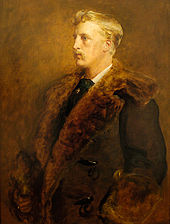 The Marquess of Lorne, Louise's husband
The Marquess of Lorne, Louise's husband See also: Wedding dress of Princess Louise, Duchess of Argyll
See also: Wedding dress of Princess Louise, Duchess of ArgyllLouise became engaged to the Marquess of Lorne on 3 October 1870.[2] Lorne was invited to Balmoral Castle in Scotland, and accompanied Louise, the Lord Chancellor, Lord Hatherley and Queen Victoria's lady-in-waiting, Jane, Marchioness of Ely on a drive. Later that day, Louise returned and announced to the Queen that Lorne had “spoken of his devotion” to Louise, and she accepted his proposal in the knowledge of the Queen's approval.[25] The Queen found it difficult to let go of her daughter, confiding in her journal that she “felt painfully the thought of losing her”.[25] The new breach in royal tradition caused surprise, especially in Germany, and Queen Victoria wrote to the Queen of Prussia that princes of small impoverished German houses were “very unpopular” in Britain and that Lord Lorne, a “person of distinction at home” with “an independent fortune” was “really no lower in rank than minor German Royalty”.[26]
Victoria settled an annuity on Louise shortly before her marriage.[27] The ceremony was conducted at St George's Chapel at Windsor Castle on 21 March 1871,[3][28] and the crowd outside was so large that, for the first time, policemen had to form chain barriers to keep control.[29] Louise wore a wedding veil of Honiton lace that she designed herself, and was escorted into the Chapel by her mother, and her two eldest brothers, the Prince of Wales and the Duke of Edinburgh. On this occasion, the usually severe black of the Queen's mourning dress was relieved by the crimson rubies and blues of the Garter star. Following the ceremony, the Queen kissed Louise, and Lorne – now a member of the royal family, but still a subject – kissed the Queen's hand. The couple then journeyed to Claremont in Surrey for the honeymoon, but the presence of attendants on the journey, and at meal times, made it impossible for them to talk privately.[30] The short four-day visit did not pass without an interruption from the Queen, who was curious about her daughter's thoughts on married life.[31]
Viceregal Consort of Canada
Inauspicious arrival
In 1878, British Prime Minister, Benjamin Disraeli, chose Lorne to be Canada's new Governor General, and he was duly appointed by Queen Victoria.[32] Louise thus became his Viceregal Consort. On 15 November 1878, the couple left Liverpool and arrived to be sworn in at Halifax on 25 November.[33]
Louise became the first royal to take up residence in Rideau Hall, officially the Queen's royal residence in Ottawa. However, the hall was far from the splendour of British royal residences, and, as each viceregal couple decorated the hall with their own furnishings, and thus took them when they departed, the Lornes found the palace sparse in décor upon their arrival. Louise put her artistic talents to work and hung many of her watercolour and oil paintings around the hall, also installing her sculpted works. Though the news that a daughter of the Queen would be viceregal consort of Canada first saw a "thrill of joy burst upon the Dominion", it being felt that the Princess would be a strong link between Canadians and their sovereign,[34] the arrival of the new governor general and his wife was not initially welcomed by the Canadian press, which complained about the imposition of royalty on the country's hitherto un-regal society.[35] Relations with the press further deteriorated when Lorne's private secretary, Francis de Winton, threw four journalists off the royal train. Although the Lornes had no knowledge of de Winton's action, it was assumed by the press that they did, and they earned an early reputation for haughtiness.[36] Louise was horrified by the negative press, and when she heard about reports of "a nation of flunkies" at the viceregal court, taking lessons in "the backward walk," Louise declared that she "wouldn't care if they came in blanket coats!"[37] Eventually the worries of a rigid court at Rideau Hall and the "feeble undercurrent of criticism" turned out to be unfounded as the royal couple proved to be more relaxed than their predecessors.[38]
Canadian entertainments
Louise's first few months in Canada were tinged with sadness as her favourite sister, Alice, Grand Duchess of Hesse, died on 14 December 1878. Although homesick over that first Christmas, Louise soon grew accustomed to the winter climate. Sleighing and skating were two of her favourite pastimes. In Canada, as the monarch's direct representative, Lorne always took precedence over his wife, so that at the Canadian State Opening of Parliament on 13 February 1879, Louise was ranked no differently than others in attendance. She had to remain standing with the MPs, until Lorne asked them to be seated.[39] In order for Lorne to meet every Canadian member of parliament, he held bi-weekly dinners for 50 people. However, some of the Canadian ladies responded negatively to the British party. One of Louise's ladies-in-waiting reported that some of them had an “‘I'm as good as you’ sort of manner when one begins a conversation.”[40] Court entertainments were open; anyone who could afford the clothing to attend functions was simply asked to sign the visitor's book.[41] Louise's first state ball was given on 19 February 1879, and she made a good impression on her guests when she ordered the silk cordon, separating the viceregal party from the guests, be removed. However, the ball was marred by various mishaps, including a drunken bandsman nearly starting a fire by pulling a curtain over a gas lamp.[41] The open house practice was criticised by guests who complained about the low social status of other guests. One attendee was horrified on discovering that they were dancing in the same social set as their grocer.[41]
Louise and Lorne founded the Royal Canadian Academy of Arts, and enjoyed visiting Quebec, which they made their summer home, and Toronto. Louise served as the patroness of the Ladies' Educational Association, of the Woman's Protective Immigration Society, of the Society of Decorative Arts and of the Art Association, all of Montreal. One of her works as a sculptor is the statue of her Royal mother Queen Victoria erected in front of the Royal Victoria College, Montreal.[1][page needed]
Lorne's father, the Duke of Argyll, arrived with two of his daughters in June, and in the presence of the family, Louise caught a 28 pound (almost 13 kg) salmon.[42] The women's success at fishing prompted the Duke to remark that fishing in Canada required no skill.[42]
Sleigh accident
Louise, Lorne, and two attendants, were the victim of a sleigh accident on 14 February 1880.[43] The winter was particularly severe, and the carriage in which they were travelling overturned, throwing the coachman and footman from the sleigh. The horses then panicked, and dragged the overturned carriage over more than 400 yards (370 m) of ground. Louise was knocked unconscious when she hit her head on the iron bar supporting the roof, and Lorne was trapped underneath her, expecting “the sides of the carriage to give way at any moment”.[44][45] Eventually, as they overtook the sleigh ahead, the horses calmed, and the occupant of that sleigh, Princess Louise's aide-de-camp, ordered an empty carriage to convey the injured party back to Rideau Hall.[46]
The doctors who attended Louise reported that she was severely concussed and in shock, and that “it was a wonder her skull was not fractured”.[46] Louise's ear had been injured when her earring caught on the side of the sleigh, tearing her ear lobe in two.[46] The press played down the story on instructions from Lorne's private secretary, an act that was described by contemporaries as “stupid and ill advised”.[47] For example, one New Zealand newspaper reported, "Excepting immediately after the blow, the Princess was perfectly sensible during the whole time..."[45] Knowledge of Louise's true condition might have elicited sympathy from the Canadian people. As it was, one Member of Parliament wrote: “Except the cut in the lower part of the ear I think there was no injury done worth mentioning.”[47] Therefore, when Louise cancelled her immediate engagements, people thought she was malingering. News of the accident was also played down in Britain, and in letters home to the anxious Queen Victoria.[47]
Continued Interest in Canada
After returning to Britain in 1879, Louise continued to take an interest in Canada. During the North-West Rebellion of 1885 she sent a certain Dr. Boyd with medical supplies and a large fund of money for distribution. Her express instructions were that assistance was to be rendered to friend and foe indiscriminately. To fulfill her wishes, the Chief of Medical Staff for the government forces, Dr. Thomas Roddick and Dr. Boyd went to the sites of the Battle of Fish Creek and the Battle of Batoche to locate and give medical treatment to wounded Métis.[48]
Victoria's last years
Family conflict
British Royalty House of Saxe-Coburg and Gotha 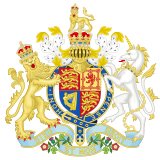
Descendants of Victoria & Albert Victoria, Princess Royal Edward VII Princess Alice Alfred, Duke of Saxe-Coburg & Gotha Princess Helena Princess Louise Arthur, Duke of Connaught Leopold, Duke of Albany Princess Beatrice Louise returned to Britain, from Quebec, with her husband on 27 October 1883, and landed at Liverpool.[49] Queen Victoria had prepared apartments at Kensington Palace, and the couple took up official residence there. Louise retained those apartments until her death there 56 years later. Lorne resumed his political career, campaigning unsuccessfully for the Hampstead seat in 1885. In 1896, he won the South Manchester seat, entering parliament as a Liberal. Louise, unlike Lorne and his father, was in favour of Irish Home Rule, and was disappointed when he defected from Gladstonian Liberalism to the Liberal Unionists.[50] Relations between Louise and Lorne were strained, and, despite the Queen's attempts to keep them under one roof, they often went their separate ways.[51] Even when he accompanied Louise, he was not always received with favour at court, and the Prince of Wales did not take to him.[52] Out of all the royal family, Lorne was the only one to be identified closely with a political party, having been a Gladstonian liberal in the House of Commons.[33] Louise's relationship with the two sisters closest to the Queen, Beatrice and Helena, was strained at best. Beatrice had married the tall and handsome Prince Henry of Battenberg in a love match in 1885, and they had four children. Louise, who had a jealous nature, had grown accustomed to treating Beatrice with pity on account of the Queen's constant need for her.[53] Beatrice's biographer, Matthew Dennison, claims that in contrast to Beatrice, Louise remained strikingly good looking throughout her forties.[54] Louise and her husband were no longer close, and rumours spread about Lorne's alleged homosexuality. Thus, Beatrice was enjoying a satisfying sexual relationship with her popular husband, which Louise was not.[55] Louise may have considered Prince Henry a more appropriate husband for herself.[53] Certainly, following Prince Henry's death in 1896, Louise wrote that: “he [Henry] was almost the greatest friend I had—I, too, miss him more than I can say”.[53] In addition, Louise attempted to champion her late brother-in-law by announcing that she was his confidante and that Beatrice, a mere cipher, meant nothing to him.[56]
Rumours of affairs
Further rumours spread that Louise was having an affair with Arthur Bigge, later Lord Stamfordham, the Queen's assistant private secretary. Beatrice mentioned the rumours to the Queen's physician, calling it a “scandal”,[54] and Prince Henry claimed to have seen Bigge drinking to Louise's health at dinner.[54] Louise denied the rumour, claiming that it was started by Beatrice and Helena to undermine her position at court.[57] However, on Henry's death, relations between the sisters sporadically improved, and it was Louise, rather than the Queen, who was the first to arrive at Cimiez to be with the widowed Beatrice.[58] Nevertheless, Louise's jealousy did not evaporate completely. James Reid, the Queen's physician, wrote to his wife a few years later: “Louise is as usual much down on her sisters. Hope she won't stay long or she will do mischief!”[59][clarification needed]
Rumours of affairs did not surround only Bigge. In 1890, the sculptor Joseph Edgar Boehm died in Louise's presence at his studio in London, leading to rumours that the two were having an affair.[4] Boehm's assistant, Alfred Gilbert, who played a central role in comforting Louise after Boehm's death, and supervised the destruction of Boehm's private papers,[60] was rapidly promoted as a royal sculptor.[60] Louise was also romantically linked to fellow artist Edwin Lutyens; her equerry, Colonel William Probert; and an unnamed music master.[61] However, Jehanne Wake, Louise's biographer, argues that there is no substantial evidence to suggest that Louise had sexual relationships with anyone other than her husband.[61]
During Victoria's last years, Louise carried out a range of public duties, such as opening public buildings, laying foundation stones, and officiating at special programs. Louise, like her eldest sister Victoria, was more liberally minded, and supported the suffragist movement, completely contrary to the Queen's views.[52] Louise privately visited Britain's first female doctor, Elizabeth Garrett.[62] Queen Victoria deplored the idea of women joining professions, especially the medical profession, and described the training of female doctors as a “repulsive subject”.[63]
Unconventional royal
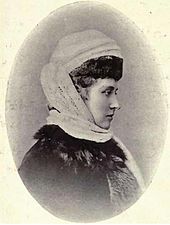 Princess Louise, Duchess of Argyll c. 1900 by William James Topley
Princess Louise, Duchess of Argyll c. 1900 by William James Topley
Louise was determined to be seen as an ordinary person and not as a member of the court. When travelling abroad, she often used the alias “Mrs Campbell”.[52] Louise was known for her charity towards servants. On one occasion, the butler approached her and requested permission to dismiss the second footman, who was late getting out of bed. When she advised that the footman be given an alarm clock, the butler informed her that he already had one. She then went so far as to suggest a bed that would throw him out at a specified time, but she was told this was not feasible. Finally, she suggested that he might be ill, and when checked, he was found to be suffering from tuberculosis. The footman was therefore sent to New Zealand to recover.[52] On another occasion, when she visited Bermuda, she was invited to a reception and chose to walk rather than be driven. She became thirsty along the way and stopped at a house, where she asked a black woman named Mrs McCarthy for a glass of water. Owing to the scarcity of water, the woman had to go some distance to obtain it, but was reluctant because she had to finish her ironing. When Louise offered to continue the ironing, the woman refused, adding that she was in a great hurry to finish so that she could go and see Princess Louise. Realising that she had not been recognised, Louise enquired whether McCarthy would recognise her again. When the woman said that she would have thought so, but was admittedly unsure, Louise replied: “Well take a good look at me now, so you can be sure to know me tomorrow at St. Georges.”[64] The Princess clung to her privacy, and enjoyed not being recognised.[65]
Louise and her sisters had another disagreement after the death of the Queen's close friend, Jane Spencer, Baroness Churchill. Determined not to put her mother through more misery, Louise wanted the news to be broken to the Queen gradually. When this was not done, Louise voiced her sharp criticism of Helena and Beatrice.[66] One month later, on 22 January 1901, Queen Victoria died at Osborne House on the Isle of Wight.[67] In her will, the Queen bequeathed Kent House, on the Osborne Estate, to Louise as a country residence,[68] and gave Osborne Cottage to Louise's youngest sister, Beatrice. Louise and Beatrice were now neighbours both at Kensington Palace and Osborne.[69]
Later life
Edwardian period
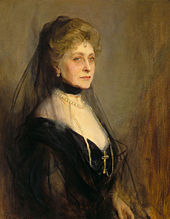 Princess Louise as a widow, painted by the society portraitist Philip de László in 1915
Princess Louise as a widow, painted by the society portraitist Philip de László in 1915
Upon Queen Victoria's death, Louise entered the social circle of her brother, the new King Edward VII, with whom she had much in common, including smoking.[70] She had an obsession with physical fitness, and if she was sneered at for this, she would retort by saying: “Never mind, I'll outlive you all.”[71] Meanwhile, Louise's husband, 9th Duke of Argyll since 1900, took his seat in the House of Lords. The Colonial Secretary, Joseph Chamberlain, offered him the office of Governor General of Australia that year, but the offer was declined.[33] Louise continued her sculpture, and in 1902, designed a memorial to the colonial soldiers who died in the Boer War.[72] In the same year, she began a nude study on a married woman suggested by the English painter Sir William Blake Richmond.[72]
Louise spent much of her time at Kent House, and she frequently visited Scotland with her husband. Financial pressures did not disappear when Lorne became Duke, and Louise avoided inviting the King to Inveraray, Argyll's ancestral home, because the couple were economising. When Queen Victoria had visited the house before Lorne became Duke of Argyll, there were seventy servants and seventy-four dogs.[70] By the time of Edward VII's accession, there were four servants and two dogs.[70]
The Duke of Argyll's health continued to deteriorate. He became increasingly senile, and Louise nursed him devotedly from 1911. In these years Louise and her husband were closer than they had been before.[4] In spring 1914 Louise stayed at Kensington Palace while her husband remained on the Isle of Wight. He developed bronchial problems followed by double pneumonia. Louise was sent for on 28 April 1914, and he died on 2 May.[73] Following his death, Louise had a nervous breakdown and suffered from intense loneliness, writing to a friend shortly afterwards: “My loneliness without the Duke is quite terrible. I wonder what he does now!”[74]
Last years
Louise spent her last years at Kensington Palace, occupying rooms next to her sister Princess Beatrice. She made occasional public appearances with the royal family, such as at the Cenotaph at Whitehall on 11 November 1925. However, her health deteriorated. In 1935, she greeted her nephew, King George V, and his wife, Queen Mary, at Kensington Town Hall during their Silver Jubilee celebrations, and was made an Honourary Freeman of the Borough of Kensington. Her last public appearance occurred in 1937, at the Home Arts and Industries Exhibition. Between these occasions, her great nephew, King Edward VIII, abdicated on 11 December 1936. In December 1936, Louise wrote to the British prime minister, Stanley Baldwin, sympathising with him about the crisis.[75]
Following the accession of Edward's brother King George VI, she became too ill to move around, and was confined to Kensington Palace, affectionately called the “Auntie Palace” by Princess Elizabeth and Princess Margaret.[76] She developed neuritis in her arm, inflammation of the nerves between the ribs, fainting fits, and sciatica. Louise occupied herself by drafting prayers, one of which was sent to Neville Chamberlain, reading "Guide our Ministers of State and all who are in authority over us ... "[77]
Louise died at Kensington Palace on the morning of 3 December 1939 at the age of 91,[78] wearing the wedding veil she wore 68 years previously.[79] Following a simple funeral owing to the war, her remains were cremated at Golders Green Crematorium on 8 December.[80] Her ashes were quietly placed in the Royal Crypt at St. George's Chapel on 12 December, with many members of the Royal and Argyll families present.[80] Her ashes were later moved to the Royal Burial Ground, Frogmore near Windsor, on 13 March 1940.[81]
Legacy
Louise's will stated that if she died in Scotland she should be buried at Kilmun next to her husband; if in England, at Frogmore near her parents.[80] In the end she was buried at Windsor.[80] Her coffin was borne by her own regiment, The Argyll and Sutherland Highlanders of Canada, whose current Colonel-in-Chief, her great-great-niece Princess Elizabeth, later Queen Elizabeth II, was among those at her funeral on 12 December 1939. Louise also bestowed her name on three other Canadian regiments: the Princess Louise Dragoon Guards in Ottawa, Ontario (inactive since 1965); the 8th Canadian Hussars (Princess Louise's) in Moncton, New Brunswick; and the Princess Louise Fusiliers in Halifax, Nova Scotia.
Queen Elizabeth II later recalled that Louise and her sister Beatrice would talk until they stunned their audience with their output of words.[82]
Louise was the most artistically talented of Queen Victoria's daughters. As well as being an able actress, pianist and dancer, she was a prolific artist and sculptress. When Louise sculpted a statue of the Queen, portraying her in Coronation robes, the press claimed that her tutor, Sir Edgar Boehm, was the true creator of the work. The claim was denied by Louise's friends, who asserted her effort and independence.[83] A memorial to her brother-in-law, Prince Henry of Battenberg, and a memorial to the Colonial soldiers who fell during the Boer War, reside at Whippingham Church on the Isle of Wight, and another statue of Queen Victoria remains at McGill University in Montreal.[4]
The province of Alberta in Canada is named after her. Although the name “Louise” was originally planned, the Princess wished to honour her dead father, so her last name was chosen. Lake Louise in Alberta is also named after her, as is Mount Alberta. Although her time in Canada was not always happy, she liked the Canadian people and retained close links with her Canadian regiments.[4] Back at home, she gained a reputation for paying unscheduled visits to hospitals, especially during her later years.[4]
Her relationship with her family was generally close. Although at times she bickered with the Queen, and her sisters Helena and Beatrice, the relations did not remain strained for long. She retained a lifelong correspondence with her brother, Prince Arthur, and was one of King Edward VII's favourite sisters.[84] Of all her siblings, she was closest to Prince Leopold, later Duke of Albany, and she was devastated by his death in 1884.[85] In the younger generations of the family, Louise's favourite relatives were the Duke and Duchess of Kent.[76] At the coronation of King George VI in 1937, Louise lent the Duchess the train that she designed and wore for the Coronation of Edward VII in 1902.[86]
Titles, styles, honours and arms
Styles of
HRH The Princess Louise
Reference style Her Royal Highness Spoken style Your Royal Highness Alternative style Ma'am 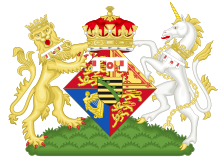 Princess Louise's coat of arms
Princess Louise's coat of arms
Titles and styles
- 18 March 1848 – 21 March 1871: Her Royal Highness The Princess Louise
- 21 March 1871 – 24 April 1900: Her Royal Highness The Princess Louise, Marchioness of Lorne
- 24 April 1900 – 3 December 1939: Her Royal Highness The Princess Louise, Duchess of Argyll
Honours
- 21 January 1865: Lady of the Royal Order of Victoria and Albert (first class)[87]
- 1 January 1878: Companion of the Order of the Crown of India[88]
- 10 February 1904: Royal Family Order of King Edward VII (second class)
- 3 June 1911: Royal Family Order of King George V (second class)
- 11 May 1937: Dame Grand Cross of the Royal Victorian Order[89]
- 3 June 1918: Dame Grand Cross of the Order of the British Empire[90]
- 7 August 1885: Member of the Royal Red Cross[91]
- 12 June 1927: Dame Grand Cross of the Venerable Order of St. John[92]
Honorary military appointments
 3 July 1911: Honorary Colonel, 5th Princess Louise Dragoon Guards (which became 4th Princess Louise Dragoon Guards in 1936)
3 July 1911: Honorary Colonel, 5th Princess Louise Dragoon Guards (which became 4th Princess Louise Dragoon Guards in 1936) 22 June 1914: Colonel-in-Chief, The Argyll and Sutherland Highlanders (Princess Louise's)
22 June 1914: Colonel-in-Chief, The Argyll and Sutherland Highlanders (Princess Louise's) 15 April 1930: Colonel-in-Chief, The Argyll and Sutherland Highlanders of Canada (Princess Louise's)
15 April 1930: Colonel-in-Chief, The Argyll and Sutherland Highlanders of Canada (Princess Louise's) 14 August 1936: Colonel-in-Chief, The Princess Louise Fusiliers
14 August 1936: Colonel-in-Chief, The Princess Louise Fusiliers
Honorary roles
- President of the Women's Education Union from 1871.[4]
- Patron of the Girls' Day School Trust, 1872–1939.[4]
Arms
In 1858, Louise and the three younger of her sisters were granted use of the royal arms, with an inescutcheon of the shield of Saxony, and differenced by a label of three points argent. On Louise's arms, the outer points bore cantons gules, and the centre a rose gules. In 1917, the inescutcheon was dropped by royal warrant from George V.[93]
Ancestry
Notes
- ^ a b Morgan 1903.
- ^ a b London Gazette, 25 October 1870.
- ^ a b London Gazette, 24 March 1871.
- ^ a b c d e f g h i j k l m Stocker 2004, Louise, Princess, duchess of Argyll.
- ^ Marshall 1972, p. 122.
- ^ a b c Longford 1987, p. 195.
- ^ a b London Gazette, 17 May 1848.
- ^ Martínez 2005.
- ^ Ralph Lewis 1996.
- ^ Lang, p. 325
- ^ Later the Royal College of Art.
- ^ a b McDougall 1988, Youth (1848–1878).
- ^ Cantelupe 1949.
- ^ a b c Dennison 2007, p. 73.
- ^ Quoted by McDougall 1988, Youth (1848–1878).
- ^ Chomet 1999, pp. 20–21.
- ^ a b Dennison 2007, p. 204.
- ^ The biographers Jehanne Wake, Elizabeth Longford and Mark Stocker claim this.
- ^ Prussia and Denmark were in conflict over the Schleswig-Holstein question.
- ^ a b Buckle (Vol I), p. 632
- ^ Wake 1988, p. 100.
- ^ Benson 1938, p. 162.
- ^ a b Buckle (second series) pp. 632–633
- ^ Paraphrased from Buckle (second series) pp. 632–633.
- ^ a b Victoria, Queen (More leaves), p. 74.
- ^ Quoted in Benson 1938, p. 166.
- ^ London Gazette, 3 March 1871.
- ^ Wake 1988, p. 138.
- ^ Wake 1988, p. 139.
- ^ Wake 1988, p. 145.
- ^ Wake 1988, p. 146.
- ^ London Gazette, 15 October 1878.
- ^ a b c Waite 2000.
- ^ Sandwell 2006, p. 48.
- ^ Longford 1991, p. 45.
- ^ Longford 1991, p. 44.
- ^ Quoted in Longford 1991, p. 45.
- ^ Hubbard 1977, p. 125.
- ^ Wake 1988, p. 226.
- ^ Wake 1988, p. 227.
- ^ a b c Wake 1988, p. 228.
- ^ a b Wake 1988, p. 230.
- ^ Wake 1988, p. 236.
- ^ Quoted in Wake 1988, p. 236.
- ^ a b Nelson Evening Mail (New Zealand), Supplement, Saturday, May 8, 1880, citing the World of March 2.
- ^ a b c Wake 1988, p. 237.
- ^ a b c Wake 1988, p. 238.
- ^ MacDermot 1938, pp. 71,75.
- ^ Wake 1988, p. 264.
- ^ Wake 1988, p. 282.
- ^ Wake 1988, p. 270.
- ^ a b c d McDougall 1988, Later years (1883–1939).
- ^ a b c Dennison 2007, p. 198.
- ^ a b c Dennison 2007, p. 199.
- ^ Wake 1988, p. 315.
- ^ Lutyens 1961, p. 52.
- ^ Dennison 2007, p. 201.
- ^ Dennison 2007, p. 200.
- ^ Reid, p. 208
- ^ a b Stocker 2004, (Joseph) Edgar Boehm.
- ^ a b Wake 1988, p. 321.
- ^ Wake 1988, p. 98.
- ^ Longford 1987, p. 395.
- ^ Wake 1988, pp. 258–259.
- ^ Wake 1988, p. 259.
- ^ Longford 1991, p. 70.
- ^ Longford 1987, pp. 561–562.
- ^ Dennison 2007, p. 226.
- ^ Wake 1988, p. 346.
- ^ a b c Longford 1991, p. 74.
- ^ Quoted in Longford 1991, p. 74.
- ^ a b Longford 1991, p. 73.
- ^ Longford 1991, p. 77.
- ^ Quoted in Longford 1991, p. 77.
- ^ Longford 1991, p. 306.
- ^ a b Longford 1991, p. 80.
- ^ Longford 1991, p. 81.
- ^ London Gazette, 1 December 1939.
- ^ Wake 1988, p. 413.
- ^ a b c d Wake 1988, p. 412.
- ^ Longford 1991, p. 83.
- ^ Wake 1988, p. 410.
- ^ Wake 1988, p. 302.
- ^ Wake 1988, p. 350.
- ^ Wake 1988, p. 269.
- ^ Wake 1988, p. 411.
- ^ Wake 1988, p. 68.
- ^ London Gazette, 4 January 1878.
- ^ London Gazette, 11 May 1937.
- ^ London Gazette, 4 June 1918.
- ^ London Gazette, 11 August 1885.
- ^ London Gazette, 14 June 1927.
- ^ Velde, Francois R.. "Heraldica – British Royalty Cadency". Heraldica.org. http://www.heraldica.org/topics/britain/cadency.htm. Retrieved 2011-08-20.
References
- Benson, E. F. (1938). Queen Victoria's Daughters. Appleton & Company.
- Buckle, George Earle (1926). Letters of Queen Victoria 1862–1878. London: John Murray.
- Cantelupe, Dorothy (1949). "Princess Louise, Duchess of Argyll". Oxford Dictionary of National Biography (online, DNB Archive ed.). Oxford University Press. http://www.oxforddnb.com/view/olddnb/34601. Retrieved 2007-01-25.
- Chomet, Seweryn (1999). Helena: A princess reclaimed. New York: Begell House. ISBN 1-56700-145-9.
- Dennison, Matthew (2007). The Last Princess: The Devoted Life of Queen Victoria's Youngest Daughter. London: Weidenfeld & Nicolson. ISBN 978-0-297-84794-6.
- Hubbard, R.H. (1977). Rideau Hall. Montreal and London: McGill-Queen's University Press. ISBN 978-0773503106.
- Jaffe, Deborah (2000). Victoria: A Celebration. London: Carlton Books Limited. ISBN 1-84222-180-9.
- Longford, Elizabeth (1987). Victoria R. I. (Second ed.). London: Weidenfeld & Nicolson. ISBN 0-297-84142-4.
- Longford, Elizabeth (1991). Darling Loosy: Letters to Princess Louise 1856 to 1939. London: Weidenfeld & Nicolson. ISBN 0-297-81179-7.
- Lutyens, Mary (1961). Lady Lytton's Diary. London: Rupert Hart-Davies.
- MacDermot, H.E. (1938). Sir Thomas Roddick: His Work in Medicine and Public Life. Canada: MacMillan Co. http://books.google.com/books?id=hXwXAQAAMAAJ. Retrieved 22 August 2011.
- Marshall, Dorothy (1972). The Life and Times of Victoria. London: Weidenfeld & Nicolson. OCLC 300168891.
- Martínez, Tori V. (2005). "Swiss Cottage: A Royal Playhouse". Time Travel Britain. http://www.timetravel-britain.com/articles/london/swiss.shtml. Retrieved 23 August 2011.
- McDougall, D. Blake (1988). "Princess Louise Caroline Alberta". Edmonton Legislature Library. Legislative Assembly of Alberta. http://www.assembly.ab.ca/lao/library/louise/index.htm. Retrieved 22 August 2011.
- McDougall, D. Blake (1988). "Princess Louise Caroline Alberta, Youth (1848–1878)". Edmonton Legislature Library. Legislative Assembly of Alberta. http://www.assembly.ab.ca/lao/library/louise/youth.htm. Retrieved 22 August 2011.
- McDougall, D. Blake (1988). "Princess Louise Caroline Alberta, Later years (1883–1939)". Edmonton Legislature Library. Legislative Assembly of Alberta. http://www.assembly.ab.ca/lao/library/louise/later.htm. Retrieved 22 August 2011.
- Morgan, Henry James (1903). Types of Canadian women and of women who are or have been connected with Canada. Toronto: William Briggs. http://www.archive.org/details/typesofcanadianw01morguoft. Retrieved 22 August 2011.
- Ralph Lewis, Brenda (1996). "Princess Louise". Britannia Internet Magazine. http://www.britannia.com/history/biographies/louise.html. Retrieved 23 August 2011.
- Sandwell, R.W. (2006). "Dreaming of the Princess: Love, Subversion, and the Rituals of Empire in British Columbia, 1882". In Coates, Colin MacMillan. Majesty in Canada: Essays on the Role of Royalty. Toronto: Dundurn Press Ltd. ISBN 978-1-55002-586-6. http://books.google.com/?id=FhFyvhpPx8MC&lpg=PP1&pg=PA44#v=onepage&q&f=false. Retrieved 22 August 2011.
- Stocker, Mark (September 2004). "Louise, Princess, duchess of Argyll (1848–1939)". Oxford Dictionary of National Biography (online, January 2008 ed.). Oxford University Press. doi:10.1093/ref:odnb/34601. http://www.oxforddnb.com/view/article/34601. Retrieved 23 January 2008.
- Stocker, Mark (September 2004). "(Joseph) Edgar Boehm". Oxford Dictionary of National Biography (online, January 2008 ed.). Oxford University Press. doi:10.1093/ref:odnb/2762. http://www.oxforddnb.com/view/article/2762. Retrieved 2008-01-25.
- Victoria, Queen (1884). More Leaves from the Journal of a Life in the Highlands from 1862 to 1882. London: Smith & Elder, & Co. http://books.google.com/books?id=_Mw-CB0a-SMC&pg=PP3#v=onepage&q&f=false. Retrieved 22 August 2011.
- Waite, P. B. (2000). "John Campbell, 9th Duke of Argyll". Dictionary of Canadian Biography. Library and Archives Canada and University of Toronto. http://www.biographi.ca/009004-119.01-e.php?BioId=41389. Retrieved 22 August 2011.
- Wake, Jehanne (1988). Princess Louise: Queen Victoria's unconventional daughter. London: Collins. ISBN 0-00-217076-0.
- London Gazette: no. 20857. pp. 1935–1938. 17 May 1848. Retrieved 2008-02-05.
- London Gazette: no. 23671. p. 4593. 25 October 1870. Retrieved 2008-02-05.
- London Gazette: no. 23712. p. 1236. 3 March 1871. Retrieved 2008-02-05.
- London Gazette: no. 23720. pp. 1587–1598. 24 March 1871. Retrieved 2008-02-05.
- London Gazette: no. 24539. p. 113. 4 January 1878. Retrieved 2008-02-05.
- London Gazette: no. 24633. p. 5559. 15 October 1878. Retrieved 2008-02-05.
- London Gazette: no. 25449. p. 3701. 11 August 1885. Retrieved 2008-02-05.
- London Gazette: (Supplement) no. 30730. p. 6685. 4 June 1918. Retrieved 2008-02-05.
- London Gazette: (Supplement) no. 33284. p. 3074. 14 June 1927. Retrieved 2008-02-05.
- London Gazette: (Supplement) no. 34396. p. 3074. 11 May 1937. Retrieved 2008-02-05.
- London Gazette: (Supplement) no. 34746. p. 8097. 1 December 1939. Retrieved 2008-02-05.
Princess Louise, Duchess of ArgyllCadet branch of the House of WettinBorn: 18 March 1848 Died: 3 December 1939Honorary titles Preceded by
The Marchioness of Dufferin and AvaViceregal consort of Canada
1878–1883Succeeded by
The Marchioness of LansdowneBritish princesses The generations indicate descent from George I, who formalised the use of the titles prince and princess for members of the British Royal Family. Where a princess may have been or is descended from George I more than once, her most senior descent, by which she bore or bears her title, is used. 1st generation 2nd generation 3rd generation - Augusta, Duchess of Brunswick
- Princess Elizabeth
- Princess Louisa
- Caroline Matilda, Queen of Denmark and Norway
4th generation 5th generation 6th generation 7th generation - Louise, Princess Royal and Duchess of Fife
- Princess Victoria
- Maud, Queen of Norway
- Marie, Queen of Romania
- Victoria Melita, Grand Duchess of Hesse
- Alexandra, Princess of Hohenlohe-Langenburg
- Beatrice, Duchess of Galliera
- Margaret, Crown Princess of Sweden
- Patricia of Connaught
- Alice, Countess of Athlone
- Marie Louise, Princess Maximilian of Baden
- Alexandra, Grand Duchess of Mecklenburg-Schwerin
- Olga of Hanover
8th generation 9th generation - Queen Elizabeth II
- Margaret, Countess of Snowdon
- Alexandra, The Hon Lady Ogilvy
10th generation 11th generation Princesses (by birth) of Saxe-Coburg and Gotha, duchesses in Saxony 1st generation none2nd generation Victoria, Duchess of Nemours · Charlotte, Empress of Mexico*3rd generation Victoria, German Empress** · Alice, Grand Duchess of Hesse and by Rhine** · Helena, Princess Christian of Scheswig-Holstein** · Louise, Duchess of Argyll** · Beatrice, Princess Henry of Battenberg** · Clotilde, Archduchess Joseph Karl of Austria · Amalie, Duchess Maximilian Emanuel in Bavaria · Louise-Marie, Princess of Kohary* · Stéphanie, Crown Princess of Austria* · Henriette, Duchess of Vendôme* · Princess Joséphine-Marie* · Clémentine, Princess Napoléon* · Joséphine-Caroline, Princess Karl Anton of Hohenzollern*4th generation Louise, Duchess of Fife** · Princess Victoria** · Maud, Queen of Norway** · Marie, Queen of Romania** · Victoria Melita, Grand Duchess Cyril Vladimirovich of Russia** · Alexandra, Princess of Hohenlohe-Langenburg** · Beatrice, Duchess of Galliera** · Margaret, Crown Princess of Sweden** · Lady Patricia Ramsay** · Alice, Countess of Athlone** · Dorothea, Duchess of Schleswig-Holstein-Sonderburg-Augustenburg · Marie-José, Queen of Italy*5th generation Mary, Countess of Harewood** · Sibylla, Duchess of Västerbotten** · Caroline Mathilde, Countess of Castell-Rüdenhausen** · Princess Clementine, Mrs. Edward von Heller · Princess Maria Caroline · Theresia, Freifrau von Taxis di Bordogna e Valnigra · Princess Leopoldine · Princess Maria Immaculata · Josephine, Freifrau von Baratta-Dragono6th generation Princess Claudia, Mrs. Gion Schäfer · Beatrice Charlotte, Princess of Saxe-Meiningen7th generation Princess Stephanie · Princess Felicitas Franziska, Mrs. Sergei Trotzki* also a princess of Belgium
** also a princess of the United Kingdom of Great Britain and IrelandRoyal Tunbridge Wells Locations within
Tunbridge WellsBuildings High Brooms station · High Rocks halt · Holy Trinity Church · Kent and Sussex Hospital · King Charles the Martyr Church · Hungershall Forge · Royal Victoria Place · Standings Mill · Tunbridge Wells station · Tunbridge Wells West stationBusinesses People List of people from Royal Tunbridge Wells · Disgusted of Tunbridge WellsPolitical Tunbridge Wells constituency (since 1974) · Tunbridge Wells borough (since 1974) · Local elections (1998, 1999, 2000, 2002, 2003, 2004, 2006, 2007, 2008, 2010)Schools and colleges Sport, leisure and the arts Assembly Hall Theatre · BBC Radio Kent · Dunorlan Park · High Rocks · Ice Melters Curling Club · KMFM West Kent · Linden Park Cricket Club · Nevill Ground · South East Today · Spa Valley Railway · Trinity Theatre · Tunbridge ware · Tunbridge Wells Cricket Week · Tunbridge Wells Football club · Tunbridge Wells Forum · Tunbridge Wells Half Marathon · Tunbridge Wells Rugby clubTwin towns Italics denotes places in East Sussex included as they are generally considered part of Tunbridge Wells. Categories:- British princesses
- British duchesses by marriage
- British feminists
- Canadian viceregal consorts
- Companions of the Order of the Crown of India
- Dames Grand Cross of the Order of the British Empire
- Dames Grand Cross of the Royal Victorian Order
- Dames Grand Cross of the Order of St John
- House of Saxe-Coburg and Gotha
- Clan Campbell
- Ladies of the Royal Order of Victoria and Albert
- Members of the Royal Red Cross
- Alumni of the Royal College of Art
- People associated with the Royal National College for the Blind
- 1848 births
- 1939 deaths
Wikimedia Foundation. 2010.

